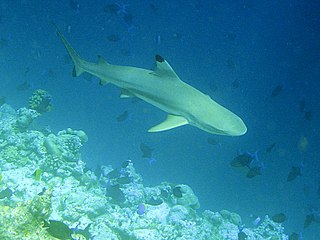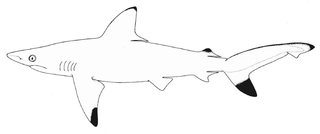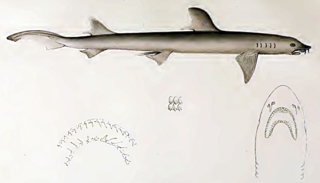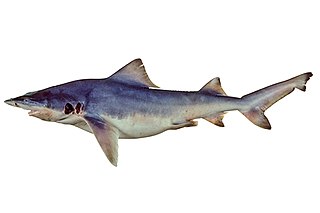
Requiem sharks are sharks of the family Carcharhinidae in the order Carcharhiniformes. They are migratory, live-bearing sharks of warm seas and include such species as the bull shark, lemon shark, spinner shark, blacknose shark, blacktip shark, grey reef shark, blacktip reef shark, silky shark, dusky shark, blue shark, copper shark, oceanic whitetip shark, and whitetip reef shark.

Glyphis is a genus in the family Carcharhinidae, commonly known as the river sharks. They live in rivers or coastal regions in and around south-east Asia and parts of Australia.

The Ganges shark is a critically endangered species of requiem shark found in the Ganges River and the Brahmaputra River of India and Bangladesh. It is often confused with the more common bull shark, which also inhabits the Ganges River and is sometimes incorrectly referred to as the Ganges shark. The genus is currently considered to contain three recent species; genetic evidence has shown that both the Borneo river shark and Irrawaddy river shark should be regarded as synonyms of the Ganges shark, expanding the range of the species to Pakistan, Myanmar, Borneo, and Java. While the other members of the genus Glyphis occur in coastal marine waters as well as rivers, the Ganges shark is found only in fresh water, making it the world's only exclusively freshwater shark. The species remains poorly known and very rare.
John Andrew Frank "Jack" Garrick was a New Zealand ichthyologist. He specialized in elasmobranchs and published many books and articles about shark and ray biology. In 1982, he published a thorough taxonomy on sharks of the genus Carcharhinus, where he identified the smoothtooth blacktip shark as a new species. He is the species authority for several types of sharks, including the New Zealand lanternshark. Garrick was a zoology professor at Victoria University of Wellington, appointed to a personal chair in 1971.
Scoliodon is a genus of requiem sharks in the family Carcharhinidae. It was formerly thought to include only a single Indo-Pacific species, the spadenose shark, but recent taxonomic research has found an additional species, the Pacific spadenose shark.

The broadfin shark is a tropical whaler shark, characterized by the broad shape of its pectoral fins. They are classified as requiem sharks of the family Carcharhinidae. This is one of two species in the genus Lamiopsis, the other being the Borneo broadfin shark. The broadfin shark is native to the northern Indian Ocean, and is found close to shore. Its current status according to the IUCN is endangered.

The speartooth shark is a rare species of river shark, belonging to the family Carcharhinidae. It inhabits coastal marine waters and tidal reaches of large tropical rivers in northern Australia and New Guinea. Despite being a member of the river shark genus, it is also found in near-shore marine waters, favoring highly turbid environments over a wide range of salinities. This robustly built, gray-colored shark is characterized by a short and broad snout, tiny eyes, a relatively large second dorsal fin, and a black blotch beneath each pectoral fin near the tip. Another identifying trait is its teeth, which are large, triangular, and serrated in the upper jaw and narrow, spear-like, and serrated only near the tips in the lower jaw. Adults grow to about 2.6 m (8.5 ft) long.

The hardnose shark is a species of requiem shark, in the family Carcharhinidae, so named because of the heavily calcified cartilages in its snout. A small bronze-coloured shark reaching a length of 1.1 m (3.6 ft), it has a slender body and a long, pointed snout. Its two modestly sized dorsal fins have distinctively elongated rear tips. The hardnose shark is widely distributed in the western Indo-Pacific, from Kenya to southern China and northern Australia. It inhabits warm, shallow waters close to shore.

The Borneo shark is a species of requiem shark, and part of the family Carcharhinidae. Extremely rare, it is known only from inshore waters around Mukah in northwestern Borneo, though it may once have been more widely distributed. A small, gray shark reaching 65 cm (26 in) in length, this species is the only member of its genus with a row of enlarged pores above the corners of its mouth. It has a slender body with a long, pointed snout and a low second dorsal fin placed posterior to the anal fin origin.

The Pondicherry shark is an extremely rare species of requiem shark, in the family Carcharhinidae. A small and stocky gray shark, it grows not much longer than 1 m (3.3 ft) and has a fairly long, pointed snout. This species can be identified by the shape of its upper teeth, which are strongly serrated near the base and smooth-edged near the tip, and by its first dorsal fin, which is large with a long free rear tip. Furthermore, this shark has prominent black tips on its pectoral fins, second dorsal fin, and caudal fin lower lobe.

The barbeled houndshark is a species of ground shark and the only member of the family Leptochariidae. This demersal species is found in the coastal waters of the eastern Atlantic Ocean from Mauritania to Angola, at depths of 10–75 m (33–246 ft). It favors muddy habitats, particularly around river mouths. The barbeled houndshark is characterized by a very slender body, nasal barbels, long furrows at the corners of the mouth, and sexually dimorphic teeth. Its maximum known length is 82 cm (32 in).

The northern river shark or New Guinea river shark is a species of requiem shark, in the family Carcharhinidae, found in scattered tidal rivers and associated coastal waters in northern Australia and in Papua New Guinea. This species inhabits areas with poor visibility, soft bottoms, and large tides, with immature sharks ranging into fresh and brackish water. It is similar to other river sharks in having a stocky grey body with a high back, tiny eyes, and broad fins. It measures up to 2.5 m (8.2 ft) long.

Dipturus is a large genus of skates native to the Pacific, Atlantic, and Indian Oceans. They were formerly included in Raja. Some species initially moved to Dipturus were later placed in Dentiraja, Spiniraja, and Zearaja.

Carcharias is a genus of mackerel sharks belonging to the family Odontaspididae. Once bearing many prehistoric species, all have gone extinct with the exception of the critically endangered sand tiger shark.

Aetobatus is a genus of eagle rays native to the Atlantic, Pacific and Indian Oceans. It was formerly placed in Myliobatidae, but is now placed in its own family Aetobatidae based on salient differences from myliobatids, especially the pectoral fins joining the head at the level of the eyes.

Galeomorphii is a superorder of cartilaginous fishes which includes all modern sharks except the dogfish and its relatives. They are sometimes called galea or galean sharks. There are about 300 living species in 23 families. Galean sharks are divided into four orders: the Heterodontiformes, Orectolobiformes, Lamniformes, and Carcharhiniformes.
The Pacific spadenose shark is a species of requiem shark, in the family Carcharhinidae. It was once regarded as conspecific to the spadenose shark.

The Indonesian whaler shark, is a species of requiem shark belonging to the family Carcharhinidae. Until recently, it was thought to be a junior synonym of the whitecheek shark. The Indonesian whaler shark, along with the family Carcharhinidae, is a key economic group in global fisheries including commercial and small-scale fisheries within the Indo-Pacific region. Common spawning and nursery areas overlap with commercial fishing grounds and it is often caught as bycatch which has caused it to be listed as a vulnerable species.















